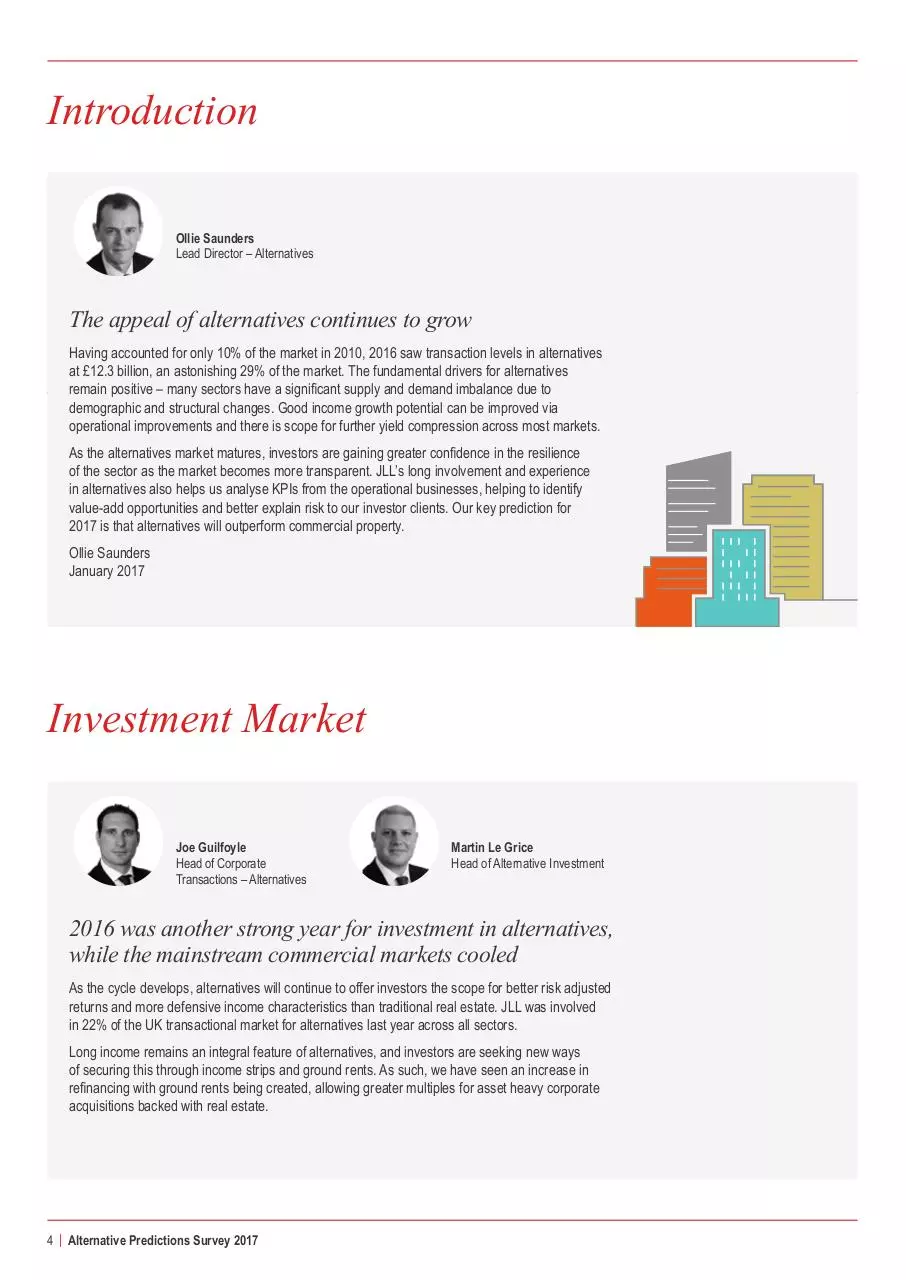pages (PDF)
File information
This PDF 1.4 document has been generated by Adobe InDesign CS6 (Macintosh) / Adobe PDF Library 10.0.1, and has been sent on pdf-archive.com on 08/06/2017 at 16:01, from IP address 46.140.x.x.
The current document download page has been viewed 317 times.
File size: 2.7 MB (32 pages).
Privacy: public file





File preview
ALTERNATIVES
PREDICTIONS
2017
UK
2 | Alternative Predictions Survey 2017
Contents
Introduction 4
Healthcare 20
Alternatives Overview
6
Leased Hotels
22
Global Capital Flows into UK Real Estate
8
Self Storage
24
Data Centres
26
Car Parks
28
Other Sectors
30
JLL’s 2017 Alternatives Investor
Predictions Survey
10
Student Housing
14
Private Rented Sector
16
Retirement Living
18
Alternative Predictions Survey 2017 | 3
Introduction
Ollie Saunders
Lead Director – Alternatives
The appeal of alternatives continues to grow
Having accounted for only 10% of the market in 2010, 2016 saw transaction levels in alternatives
at £12.3 billion, an astonishing 29% of the market. The fundamental drivers for alternatives
remain positive – many sectors have a significant supply and demand imbalance due to
demographic and structural changes. Good income growth potential can be improved via
operational improvements and there is scope for further yield compression across most markets.
As the alternatives market matures, investors are gaining greater confidence in the resilience
of the sector as the market becomes more transparent. JLL’s long involvement and experience
in alternatives also helps us analyse KPIs from the operational businesses, helping to identify
value-add opportunities and better explain risk to our investor clients. Our key prediction for
2017 is that alternatives will outperform commercial property.
Ollie Saunders
January 2017
Investment Market
Joe Guilfoyle
Head of Corporate
Transactions – Alternatives
Martin Le Grice
Head of Alternative Investment
2016 was another strong year for investment in alternatives,
while the mainstream commercial markets cooled
As the cycle develops, alternatives will continue to offer investors the scope for better risk adjusted
returns and more defensive income characteristics than traditional real estate. JLL was involved
in 22% of the UK transactional market for alternatives last year across all sectors.
Long income remains an integral feature of alternatives, and investors are seeking new ways
of securing this through income strips and ground rents. As such, we have seen an increase in
refinancing with ground rents being created, allowing greater multiples for asset heavy corporate
acquisitions backed with real estate.
4 | Alternative Predictions Survey 2017
Alternative Predictions Survey 2017 | 5
Alternatives Overview
Investment activity
In 2016 there was £12.3 billion of investment in alternatives, in line
with our prediction for the year 12 months ago. The market share
in 2016 increased noticeably from 25% in 2015 to 29% of the total
commercial property market. 2015 was a stellar year in alternatives,
with some major student housing transaction taking total deal volumes
to over £15 billion. Whilst total investment volumes are lower in 2016,
the market share for alternatives has continued to increase due to the
slowdown in traditional markets.
James Kingdom
Associate Director – Research
A look at the key themes from
2016 and for 2017
While increased economic and political uncertainty has contributed
to the slowdown in commercial investment activity, alternatives
continue to be underpinned by strong property fundamentals that
are supported by the emergence of new investable real estate
assets, driven by growing demand based on demographic changes;
increased mobility; changing lifestyle patterns and technological
advances. Many of the sectors that have previously been considered
emerging are now maturing at a considerable pace and delivering
sustainable long term income.
This paper looks at what has happened in the alternative sectors
in 2016, as well as providing our predictions for what is in store for
2017 and beyond. Our main prediction for total investment activity
in 2016 was correct, at £12 billion, and this year we set out the key
issues for each sector based on several themes.
We continue to see new entrants into alternatives, both from the
UK and overseas. As the sectors continue to evolve, the outlook
amongst the respondents of our survey is highly positive, with
the expectation that alternatives will out-perform the traditional
commercial property market in 2017.
Student housing was again the largest in terms of total investment at
£3.2 billion. This represents another strong year for the sector which
is now an established global asset class. In addition to the UK market,
there is now increased appetite for cross border portfolios.
Given the additional political uncertainty this year, this paper also
takes into consideration the key political and legislative issues
that are likely to influence each alternative sector.
32
14
28
12
24
10
20
8
16
6
12
4
8
2
4
£ billion
16
0
2008
2009
Investment
Predicted (Jan 16)
£12.6
billion
6 | Alternative Predictions Survey 2017
2010
2011
Investment
Actual
£12.3
billion
2012
2013
2014
Market share
Predicted (Jan 16)
21%
2015
2016
Market share
Actual
29%
0
Market share %
Alternatives investment volumes
Portfolios remain an important feature of alternatives, accounting for
49% of the market. Premiums for portfolios of 5% – 10% still persist
in return for the ability to purchase assets at scale. Portfolios allow
new entrants to acquire a significant level of market share in what are
generally undersupplied markets, such as the StorageMart purchase
of Big Box Self Storage. The only exception to this at present is the
PRS sector, where the majority of deals are for forward funding as a
lack of supply in the sector means that the ability to buy at scale is
not yet available.
American investors were the largest portfolio buyers last year in
healthcare, self storage and car parks, buying more than £2.3 billion
of assets. Asian buyers bought £812 million of student housing thanks
largely to Mapletree and the GIC sovereign wealth fund. Overall,
American buyers accounted for 25% of investment in alternatives
in 2016, whereas Middle East and European buyers still heavily
favour the traditional commercial sectors.
One reason for this is that many of the alternatives are more
evolved in the UK than they are in Europe, but less so than the US.
In all sectors with the exception of PRS and possibly healthcare,
the UK is the leading EMEA market. Consequently, experienced
American and other investors have the ability to buy into sectors they
understand that are attractively priced compared to domestic markets.
The nature of the UK market means there is scope of further yield
compression from both increased maturity and improved management.
This stance is supported by the fact that for each alternative
sector, the majority of respondents to our survey expect yields
to remain stable or harden further in 2017, in contrast to
commercial property where yields are forecast to soften over
the next 12 months.
Investment by sector in 2016 (£ Million)
£3,182
£2,814
£2,492
£1,805
£1,168
£627
Student
housing
Hotels
Healthcare
Private rented
sector
Leisure
Car parks and
automotive
£170
£79
Self storage
Data centres
Yield expectations 2017
n Unchanged n Softening n Hardening
Yields stable or hardening
100%
80%
60%
40%
20%
0%
-20%
-40%
-60%
Healthcare
Yields softening
Retirement
living
Hotels
Leisure
Student
Private rented
sector
Car parks and
automotive
Data centres
Self storage
Alternative Predictions Survey 2017 | 7
Global Capital Flows into UK Real Estate 2016
Americas
Alternatives
UK
Alternatives
Europe
Alternatives
Traditional Commercial
Traditional Commercial
Traditional Commercial
25%
15%
51%
49%
Middle East
Alternatives
Asia
Alternatives
Other
Alternatives
Traditional Commercial
Traditional Commercial
Traditional Commercial
2%
7%
8 | Alternative Predictions Survey 2017
4%
12%
10 %
15 %
8%
3%
How the alternative markets are maturing
Due to consistently high investment volumes and consolidation
in recent years, both student housing and leased hotels can now
be considered established markets. Care homes are still in the
process of maturing but a noticeable expansion of the private
pay mid-market will be the next process in the sector’s evolution.
Although PRS, retirement living and serviced apartments are all still
relatively new sectors, the weight of demand from demographic and
lifestyle changes are accelerating the pace of their evolution. These
sectors also have the added benefit of an increased understanding of
the operational side thanks to growth in similar, more mature sectors.
Markets continue to emerge and grow at different speeds. Sectors
such as data centres and self storage continue to mature but need
to increase the level of market transparency and attract a broader
range of investors for them to become more established.
Regardless of which stage each sector is at,
we expect investment levels to remain robust
due to the compelling fundamentals behind
each one of them.
The illustration shows the relative maturity of the main
alternative asset classes in the UK in 2017
Mental
health
Nurseries
Cemeteries
& crematoria
Higher
education
Data
Centres
Marinas
Care
Homes
Caravan and
holiday parks
Leisure
Hospitals
and Surgeries
Office
Retail
Student
Housing
Leased
Hotels
Garden
Centres
ture
Semi ma
ure
Less mat
Industrial
Serviced
apartment
Retirement
living
Self
Storage
Car parks and
automotive
PRS
Mature
Established
Maturity
Alternative Predictions Survey 2017 | 9
Download pages
pages.pdf (PDF, 2.7 MB)
Download PDF
Share this file on social networks
Link to this page
Permanent link
Use the permanent link to the download page to share your document on Facebook, Twitter, LinkedIn, or directly with a contact by e-Mail, Messenger, Whatsapp, Line..
Short link
Use the short link to share your document on Twitter or by text message (SMS)
HTML Code
Copy the following HTML code to share your document on a Website or Blog
QR Code to this page

This file has been shared publicly by a user of PDF Archive.
Document ID: 0000608961.